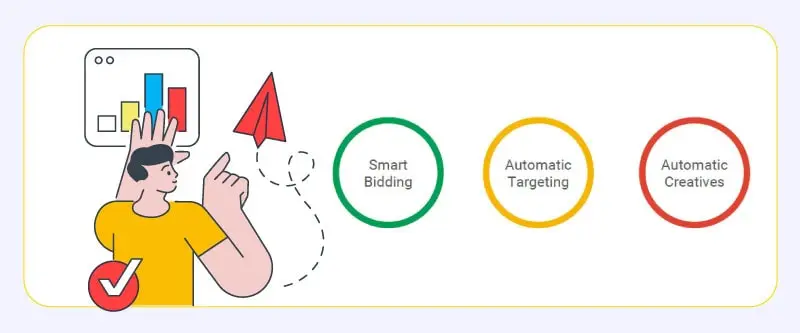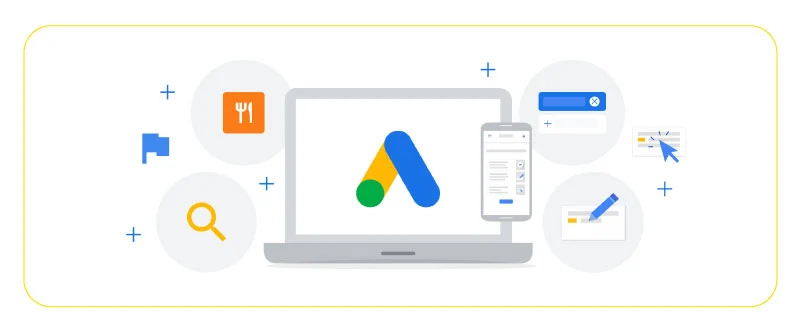As the world’s largest advertising platform, Google Ads empowers businesses of all types and sizes to reach customers globally through various effective methods, including the Google Display Network (GDN). Compared to paid search ads that are more suitable for targeting prospects with high buyer intent, display ads enable businesses to reach people at almost all stages in the customer’s journey.

GDN is exceptionally powerful in this matter thanks to its network of over 2 million websites, videos, and apps and hyper-flexible targeting, bidding, ad creation, and optimization features. Now, with the Smart Google Display Campaign, the Internet giant has taken things to the next level.
Smart Google Display campaigns are a powerful advertising tool that leverages machine learning and automation to deliver effective display ads across Google’s extensive network. With smart display campaigns, advertisers can reach a wide audience and achieve their advertising goals efficiently. By combining innovative technology and intelligent targeting, smart display campaigns offer several benefits for advertisers looking to maximize their advertising impact.
Wonder what all the fuss about this new feature is? Keep reading to find out.
What is Google Smart Display Campaign?
In recent years, major advertising platforms have started incorporating advanced automation technologies to reduce the amount of time and energy-consuming labor and guesswork and bring a higher level of accuracy and efficiency to customers. Facebook has launched its impressive Facebook Power5 project which is a series of automated tools and tactics that could manage a huge chunk of your Facebook Ad campaigns on their own.
Google is also a big player in the “automation” game. The company has already been using advanced AI and machine learning tech in its advertising platform and now, with the addition of Smart Display Campaigns, Google hopes to remove manual work even further and let its intelligent systems handle the numerous variables of display advertising. In addition to the smart display campaigns, Google has also launched the smart version of its shopping advertising service that promises better results with less time-consuming campaign management efforts. See how that fares against legacy shopping campaigns in our Google Smart Shopping Ads vs Standard Shopping Ads comparison.

So what is Google Smart Display Campaign? This type of campaign allows advertisers to show ads in almost all formats across the Display Network. In other words, with this new feature, you no longer have to create separate assets, targeting properties, and bidding strategies for different audience groups and objectives. Prior to the introduction of Smart Display Campaigns, advertisers were required to provide creatives in each ad format and size.
Now, the new system only requires you to provide the ad components and the engine will dynamically combine them and create ads for you. Smart Display can also test and optimize ad formats for you, so you’ll be saving a lot of time, money, and energy.
Much like other major online advertising platforms, Google is pushing advertisers to try out its automated systems and Smart Display Campaigns are no exception. Facebook has been doing this for a while now, so much to the point where some of the features in its advertising suite are going full automated. While AI technology is a come a long way, it’s still not 100% reliable. But there’s no doubt that AI and machine learning are already capable of handling a lot of tasks that are sometimes impossible for humans.
Let’s dive deeper into this feature to learn how it works and what benefits it provides:
Automatic bidding
The Smart Display engine is constantly monitoring the performance and can adjust your bidding automatically based on the accumulated data. It estimates the likelihood of your campaigns snatching conversions and adjusts the level of aggressiveness of your bids. The system has a learning period of two weeks, or 50 conversions, whichever comes first.
Automatic targeting
Smart Display’s automatic targeting feature gives you the advantage of reaching customers at the earlier stages of your funnel and remarkets to people who have visited your website. One of the most impressive functions of this feature is anticipating promising targeting keywords automatically based on machine learning and browser data. So if by any chance you forget to target an important keyword or there’s a very promising keyword that you haven’t thought about, the system covers it for you.
Ad creation and optimization
This is a huge step forward for Google Display ads since you could skip the exhausting part of creating multiple assets for you different campaign objectives and audience groups. All you need to do is to enter your headlines, description lines, images, and logos, and the smart campaign takes care of the rest.
The system will combine your assets to make ads that automatically resize to fit any ad format or type. You can adjust your campaign to use the best combination of texts and images based on performance reports.
When should you use Smart Display Campaigns?
- The Smart Google Display campaign is a great way to get started on display advertising since it does most of the complex manual work for you. This isn’t exclusive to newbies. GDN veterans could also save time and resources significantly with this feature. Automatic ad creation and optimization means you no longer have to spend a lot of time creating assets in different sizes and formats for your different audience groups and goals.

- If you want to broaden your reach and capture customers at earlier stages of the marketing funnel, smart campaigns could be a great help. With the automatic targeting ability, these campaigns can help you attract customers beyond your usual target audience.
- The automatic performance optimization makes testing different creatives and assets very easy. The system will regularly give you feedback on performance and lets you select the most effective combination for grabbing conversions.
How to set up a Smart Google Display Campaign
Google recommends doing the following before starting a Smart Display Campaign:
- Prepare your assets like headlines, logos, images, and descriptions
- Set up conversion tracking
- Allocate sufficient average budget to account for at least 10 times your target CPA bid
Sign in to your Google Ads account, then:
- Click Campaigns on the left menu. Then click on the plus button and select New Campaign.
- Choose one of the campaign goals based on the objective you have in your mind. It could be sales, Website traffic, or leads.
- Select Display between campaign type options, then select Smart Display Campaign as the subtype.
- Enter your website’s URL in the following field and click on Continue.
- Next, you have to select the language and locations you want to target and exclude.
- In the Bidding section, choose the metric you’d like to focus on (e.g. Conversions). Then enter your average daily budget and CPA bid. Then click Save and continue.
- Click on Additional settings. Then click on the drop-down under Dynamic Ads and check the box Use a data feed for personalized ads. Then select the appropriate data feed.
- In the additional setting sections, set the Start and End Dates, Conversions, and Content Exclusions.
- Click Save.

Here’s how to create responsive display ads:
- in the Google Ads interface, select Display Campaigns from the navigation panel on the left.
- Click on Ads & assets from the left menu.
- Click on the plus button and select Responsive display ad.
- Select an ad group.
- Add and save your assets. Google recommends entering multiple assets since it makes it easier for Google to optimize ads.
- You can upload up to 15 marketing photos and 5 logos. The source could be local, your website, or Google stock photo library.
- Landscape photos must have a 1.91:1 ratio and be larger than 600 x 314. The file size limit is 5MB.
- Square photos should have a 1:1 ration and be greater than 300 x 300. The file size limit is 5MB.
- Logos should be square and 128 x 128 or greater (recommended size is 1200 x 1200). Google recommends uploading a landscape 4:1 logo too for best rendering, which should be 512 x 128 or greater (recommended size is 1200 x 300). It’s best for centered logos to have transparent backgrounds. The file size limit is 5MB.
- Texts should not cover more than 20% of images.
- Complete your ad information
- Enter a short headline (up to 5 headlines of 30 characters or fewer). This is the first line of your ad and appears in tight spaces where long headlines don’t fit.
- Write a long headline (90 characters or fewer). It’s the first line of your ad and appears on large ads.
- Write a Description (up to 5). It can be up to 90 characters and may appear before or after your headline.
- Enter a business name.
- Enter a final URL where people will go to after clicking on your ad. You can add tracking or custom parameter to your URL in the advanced URL options section.
- Click Save.
Google Smart Display Campaign Best Practices
To make the most of your Google Smart Display campaigns and achieve optimal results, it’s essential to follow some best practices. Here are key tips and strategies to consider:
- Define clear campaign goals: Before setting up your smart display campaign, clearly define your objectives, whether it’s driving website traffic, increasing conversions, or raising brand awareness.
- Utilize responsive ads: Smart display campaigns use responsive ads that automatically adjust their format, size, and appearance to fit different ad spaces. Ensure your creative assets, such as images and headlines, are compelling and relevant to capture audience attention.
- Leverage automation and machine learning: Take advantage of Google’s machine learning capabilities to optimize your campaigns automatically. Allow the system to learn from user behavior, targeting, and ad performance to deliver better results over time.
- Target the right audience: Define your target audience based on demographics, interests, and behavior. Smart display campaigns leverage Google’s extensive user data to identify potential customers who are likely to engage with your ads and convert.
- Test and iterate: Continuously monitor the performance of your smart display campaigns and make data-driven decisions. Test different variations of your ads, including headlines, images, and calls-to-action, to determine what resonates best with your audience.
- Set a budget and bid strategically: Determine your budget based on your campaign goals and allocate it effectively. Experiment with different bidding strategies, such as target CPA (cost-per-acquisition) or target ROAS (return-on-ad-spend), to optimize your campaign’s performance.
- Monitor and optimize performance: Regularly review the performance of your smart display campaigns. Monitor key metrics like impressions, clicks, conversions, and cost per conversion. Identify underperforming elements and make adjustments accordingly.
By implementing these best practices, you can enhance the effectiveness of your Google Smart Display campaigns and maximize your advertising results.
Smart Display Campaign Targeting Options
To reach the right audience and maximize the effectiveness of your smart display campaigns, it’s crucial to understand the available targeting options. Here’s an overview of the targeting options and techniques you can utilize:
- Audience targeting: Google offers a range of audience targeting options to help you reach the most relevant users. This includes:
- Demographics: Target users based on age, gender, and other demographic factors.
- Interests: Reach users with specific interests related to your products or services.
- Affinity audiences: Target users who have shown a strong interest in a particular topic or industry.
- Custom intent audiences: Reach users based on their search behaviors and intent signals.
- Remarketing: Show your ads to users who have previously interacted with your website or app.
- Geographic targeting: Define specific locations where you want your ads to appear. This can be as broad as targeting an entire country or as specific as targeting a particular city or zip code.
- Placement targeting: Choose specific websites, apps, or placements within the Google Display Network where you want your ads to be shown. This allows you to have more control over the placement of your ads.
- Customizing targeting settings: Depending on your campaign objectives, you can customize targeting settings to further refine your audience. This includes options such as:
- Device targeting: Choose to target specific devices, such as desktop, mobile, or tablet.
- Language targeting: Show your ads to users who speak a particular language.
- Frequency capping: Control the number of times your ads are shown to the same user within a given timeframe.
Segmentation techniques:
To optimize your smart display campaigns, consider using segmentation techniques to further refine your targeting. This involves dividing your target audience into specific segments based on various factors such as demographics, interests, or past interactions. By creating tailored ad messaging and targeting for each segment, you can deliver more personalized and relevant ads to increase engagement and conversions.
Customizing targeting settings for specific campaign objectives:
Depending on your campaign objectives, you can customize your targeting settings to align with your goals. For example:
- If your objective is to increase brand awareness, you may prioritize reaching a broad audience and focus on interest-based targeting.
- If your objective is to drive conversions, you may want to focus on remarketing to users who have already shown interest in your products or services.
By utilizing the available targeting options and customizing them to suit your campaign objectives, you can ensure that your smart display campaigns reach the right audience at the right time.
Conclusion
Google Smart Display Campaign is a massive help to advertisers looking to streamline their ad management process and save time and costs and we definitely recommend you give it a try. To simplify the process of running display ads on google even more and keep track of your competitors, make sure to check out our Google Display Ads spy tool which helps you monitor your competitors and get inspiration from the most successful ads out there.
FAQs
What is a Google Smart Display campaign?
This type of campaign allows advertisers to show ads in almost all formats across the Display Network. In other words, with this new feature, you no longer have to create separate assets, targeting properties, and bidding strategies for different audience groups and objectives.
What is the difference between a display campaign and a Smart Display campaign?
Smart Display campaigns take care of the ad creation, optimization, and targeting for you while letting you choose the level of automation and monitor performance.
What are the 3 main automation components of smart display campaigns?
Automatic bidding, automatic targeting, and automatic ad creation.







 Facebook Ads Spy Tool
Facebook Ads Spy Tool TikTok Ads Spy Tool
TikTok Ads Spy Tool
2 thoughts on “Google Smart Display Campaign: How It Works And How To Use It”
I can’t get my head around the fact that many time, these AI controlled features like smart display campaigns do something really stupid on their own that could sometimes cost you a lot of money. Still prefer manual control over what I’m running.
Hi Jens Thanks for your comment. I totally get that and many people think just like you. Artificial intelligence may not be at the point where you could completely trust it with smallest details yet, but it’s certainly getting closer and closer. Just look at ChatGPT or Midjourney.